
Welcome! 08/05/08
We got our passports stamped and we started a 4 km to the Guatemalan border, leaving a wide, flat valley to a hilly, green land. This climb will escort us in the next few days. We reached a border town, a real border town: thousands of people, moving constantly, thousands of shops selling everything, from cowboy hats (every second Mexican and second Guatemalan wears them) to electronic goods. From fake indigenous crap to fake everything and it went on for more than 2 km. The houses around it were crummy shacks, built one upon the other, higher and higher into the mountains. In the middle of all this mess, a man pointed towards a booth; Gringos, go to immigration.
The few cheap hotels that Rami went to check were built of patches on patches of added rooms and floors, each with its’ own architectural style. Claustrophobic rooms with 2 beds, a lamp, a million mosquitoes, no fan and no window. Around $5 – tempting, but no thanks. We were tempted to stay, but the shitty hotels made us continue.
 La Mesilla - a real border-town.
La Mesilla - a real border-town.We were climbing again, passing a hill into a green gorge when we saw a hotel, in the middle of no-where. Gals’ knees were tiered so we decided to check it out. What’s one more hotel to check? To our surprise, it was perfect and cheap. It even had an air-conditioner and satellite TV. Everything was new and we had the whole place to ourselves.
 From our hotel roof.
From our hotel roof.The following morning we attacked Guatemala. All day long we climbed this valley, passing many villages with traditionally dressed women and children shouting “Gringo”. The highlight was a 70-year old woman, who was pointing and shouting enthusiastically; it doesn’t give the best feeling in the world.

 Cooling ourselves in a waterfall.
Cooling ourselves in a waterfall.

It was cloudy, near sunset, when we finally reached a junction to a town 2 km away. There was a basic hotel (previously a dungeon) and a few shops, but no tortillas. After a thorough search for some sort of carbohydrate, the woman from the food stall sold us 15 tortillas (not more, she didn’t have enough!), we had a traditional can of beans and a few tomatoes. We quickly continued search of a nearby house/family where we can camp safely.
After a long day of cycling in a new, unfamiliar country, very different from the previous one, fighting the unfriendly traffic, the poverty and the lack of tranquility, we still needed to find a place to camp.
 House-camping?
House-camping?The road to San-Pedro was quick; 4 days and we were in the middle of the country. We slept 3 nights in people’s houses. 2 houses were empty, in final stages of construction, and the other on a balcony of a new house of a young couple. We spent 1 night in a guest house in Quatro-Caminos and walked to the neighbor village, San Cristobal Totonicapan, and arrived to the mess of the end of the day of a BIG Sunday market. That explained the masses of locals carrying their goods, along the road, all day long. A nice, small fiesta was held near the cathedral.
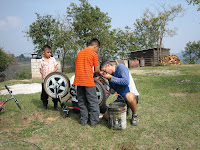 Fixing all the bicycles of the village.
Fixing all the bicycles of the village. Yo! The local enthusiasm.
Yo! The local enthusiasm. Traditionally dressed women, carrying things on their heads.
Traditionally dressed women, carrying things on their heads. The local cyclist in the background.
The local cyclist in the background.

 Women hiding their souls from the camera/devil.
Women hiding their souls from the camera/devil.After the 3,000m pass (our map ´prepared´ us for 3,670m), just near the headquarters of the Israeli road construction company “SOLEL BONEH”, everything became wet and much greener.
 The Israeli connection.
The Israeli connection.
We decided to stop for the night near a cliff, a 1,000m drop to the lake. Due to the fog, visibility was bad, so we hoped it will improve in the morning. Morning coffee was a success.
 Morning coffee. Lake Atitlan, from above.
Morning coffee. Lake Atitlan, from above. Sleeping in a house to be.
Sleeping in a house to be.

We descended the 1,000m drop (in




 Chicken bus.
Chicken bus.
San Pedro 13/05/08
Our “rest day” destination, San Pedro, is a small village on the banks of the lake, the ´backpackers hang out´. The scenery was amazing: under a volcano and facing the lake and huge cliffs. We could have only imagined the wet season, when visibility is sharp and everything is greener. The village was nice, spread on a hill, a small typical market, everybody traditionally dressed and a maze of small alleys.
Most of the thousands of tourists stayed ‘down’, near the lake. Rami preferred finding a room near the market, away from the masses of tourists, but we eventually found a nice room with a balcony facing the lake. Rami didn’t feel comfortable with all the tourists around, especially the big percentage (and big groups) of young Israelis. Some of the ‘fun-fun’ tourists weren’t even aware of the existence of a village above them.
We took the opportunity of taking a few Spanish lessons. It was recommended as a cheap and comfortable center in Central-America. Our teacher was fantastic.
We befriended Alon, an Israeli traveler on his way home. We all went horse-riding.
The Israelis have long taken over San-Pedro, or, at least, the tourist area. Everywhere you looked, there were signs in Hebrew and you could hear Hebrew being spoken. The most successful place in town was the “Zoola”, the Israeli owned restaurant/hotel.
We had a few uncomfortable incidences in which the locals expressed their hatred towards Israelis. The average young Israeli traveler was not even aware of the situation. Rami was semi-joking about the coming terror act, in the entrance to the Zoola, and a Russian security guard.
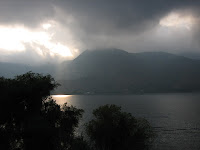

 The view from our balcony.
The view from our balcony. The butcher in the market.
The butcher in the market.

 A hair cut.
A hair cut.

 Horse riding with Alon.
Horse riding with Alon. The Israeli 'gang' from down stairs.
The Israeli 'gang' from down stairs.18/05/08
After 4 rest days we left. We took a quick Lancha (small boat) to Santiago Atitlan, a neighboring town, thus avoiding a section of road, notorious for robberies. We planned on taking the old Pan-Am highway, hoping we’ll avoid the impossible inclines on the roads leading to the new Pan-Am.
Since the morning Gal was suffering from a bite she got the previous day. As we all know, if there’s something that bites, it’ll bite Gal. Her ankle was swollen, blue and hurting. We hitched a ride for about 7km, to San-Lucas Toliman, and decided to wait there, see how Gal feels tomorrow.
The next morning the doctor in the town clinic gave Gal strong antibiotics. Since then Gal was not feeling well.
 The lancha to Santiago Atitlan.
The lancha to Santiago Atitlan.
 A 'rock' worth of vegetables.
A 'rock' worth of vegetables. Stove maintenance.
Stove maintenance.Before leaving, the following morning, Rami was sent to the market, to buy groceries for breakfast. Soon he returned excited and called Gal to join him. The quit center turned to a wild market, packed with villagers with their goods: avocados, tomatoes… anything.
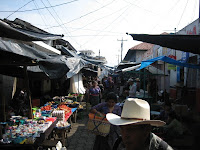

 Playing with the frijoles.
Playing with the frijoles.

 The Cowboy hat.
The Cowboy hat. Big Rami.
Big Rami.The 2 days to Antigua passed quickly. The first day we took the old Pan-Am; the whole route was beautiful, great views of the lake, and later mountains. The climb was not too bad as well.
We spent the night at Patzun, luckily arriving on the peak night of the fiesta of San-something. We barely managed to find a room. The town was packed with locals from the region. They mainly ate their terrible Guatemalan food, but some went on the ‘bumping cars’ and the brave ‘did’ the giant wheel.

 Baby strollers.
Baby strollers.
 Paracticing for a maraton, in the mountains.
Paracticing for a maraton, in the mountains.
 Another impossible incline.
Another impossible incline.

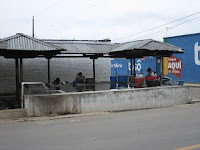 The village laundry place.
The village laundry place. Another market on the way.
Another market on the way.Antigua 21/05/08
We finally reached the famous town! Rami missed the turn off to town while zooming downhill; it took him a while to understand what Gal was shouting.
The first thing we noticed was the cobbled streets of the ‘old center’; full of charm, but terrible for cycling. While searching for a hotel we got a first tour of the town, truly beautiful, with fantastic colonial old houses, dotted with many impressive churches, some only ruins, damaged by earthquakes, only a wall or 2 left.
Our guesthouse, one of the cheapest in town, was chosen for a different reason; it had the best rooftop in town, with 360 degrees views of volcanoes, the town, with its’ broken churches, tiled roofs and lightning storms. Our room was a bit claustrophobic, but the owners were friendly, we made good use of the kitchen, did our laundry and met interesting people, like a Nicaraguan, who eats only red beans, not the Guatemalan black Frijoles, and despites the local coffee, and a Japanese cyclist, with his tragic adventures/stories (bike stolen in Las Vegas…).
Our hotel was near the big lively market, where we did our daily shopping. On our first visit, just as we were leaving, we spotted a mother & daughter, holing a basket, selling pies. We couldn’t resist the temptation and bought 1 pineapple pie and 1 strawberry pie, each costing 5 Quetzal ($0.6). In 1 minute we were chasing them for more. They were fresh, warm and melted in our mouth! We were in love! We looked for them on the next morning, but with no luck. But, we did find other pies, in many bakeries in town, Rami tasting them all, but none as delicious or as fresh. Throughout Guatemala we found lots of relatively good pastries (as opposed to ‘Bimbo’ – the Central-American wonder-bread. It reached a stage which at that ere, pies was a major portion of Ramis’ diet.
Another treat we found in the market, were strawberries and raspberries. Every day Rami bought a big bag of each, cleaned them, mixed them with sugar and let them sit for a long while, till we attacked.
We enjoyed Antigua.
 From our rooftop.
From our rooftop. The market (+ Rami).
The market (+ Rami). More market.
More market.
 Ruins.
Ruins. Strawberries and raspberries.
Strawberries and raspberries. Our claustrophobic room.
Our claustrophobic room.

 The town.
The town. Leaving.
Leaving.The wet season – part 1 25/05/08
Once in 3 months Gal had a craving for Pizza. She started her day with Pizza, the same she ate last night! It was quite good, actually.
But, who opens a Pizzeria at 09:00 in the morning?
We crossed the capital, from the south, quite quickly and returned to the ‘Campo’ (the country-side). It was a Sunday and we saw many ‘road’ cyclists.
We were climbing a big hill, chatting with 3 locals. They lured us to a shortcut. After descending about 2km on this dirt road, a passing car told us to head back; this area is dangerous, notorious for robberies. Our 3 escorts disappeared down as we decided to head back. On the tiring climb another car warned us of the area. Coming from Mexico, where we felt very safe, we felt here a big change. Many times people warned us about isolated roads, etc. Later, in Honduras, we heard from Yehonathan, an Israeli who has worked a year in security, in Guatemala, that Guatemala is by far the most dangerous of the Central-American countries, with numerous daily murders.
 Foodstall in Guatemala city area.
Foodstall in Guatemala city area.

We were back on the Pan-Am highway, when it started to rain. We quickly hid in a strange complex with a guard and many parking lots. It almost looked modern. We waited an hour during the intense rain. The amount of water – unbelievable! It was obvious that this was the beginning of the rainy season. The structure we hid in turned out to be a ‘romantic’ hotel, highly discrete, renting by the hour. It solved us the mystery of the ‘auto hotels’ we’ve been passing so often, and will see throughout Central-America.
 Outo-hotel and the rainy season.
Outo-hotel and the rainy season. Our new bungee cords.
Our new bungee cords.


 Green!
Green! Coffee.
Coffee.
The ride to the border was smooth. We added 2 tasty dished, easy to cook, to our diet, thanks to Gal: Chili chicken and marinated chicken/pork (honey-mustard-soya-garlic-ginger).
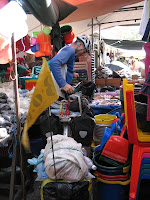 Lets go through the market...
Lets go through the market...

 Volcanoes.
Volcanoes.On our last night we slept at Jocotan. We searched for bread, a simple task in Guatemala. We passed through all the bakeries in town, searching for non-sweet bread. The first admitted the bread was sweet. The others lied and smiled stupidly, after Rami tasted it and got more and more angry, but didn’t give up.

 To the border.
To the border. Yehonatan, the Israeli motorcyclist.
Yehonatan, the Israeli motorcyclist.Goodbye 30/05/08
We didn’t like Guatemala. From the ”Gringo” shouts to the over-populated highway, the impatient drivers (the crazy “Chicken bus” drivers), the crime (dark car windows, for security reasons) and the Israeli ‘stress’ atmosphere; everybody talking on the cell-phone, always wanting to know what’s happening in this small country, always wanting more, always asking the price of our bicycles…
On the secondary roads we did take, things were much better (except for the almost impossible slopes). Maybe we should have taken the road going east from Huehuetenango to Coban, skipping the congested center.
Gal was also sick, what affected the overall vibe.
It was not all bad. People were good, welcoming us to their houses when needed, and prices were super-cheap, after Mexico. The Markets were by far the best in North/Central America (We’re currently in Panama).
The major problem was it being a small country, not giving us the opportunity to get to know it better. And, till Colombia, all through Honduras, Nicaragua, Costa-Rica& Panama we’ll have this problem.
